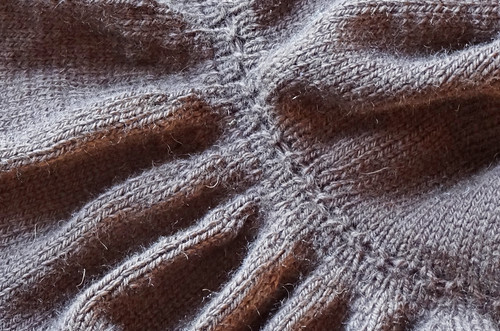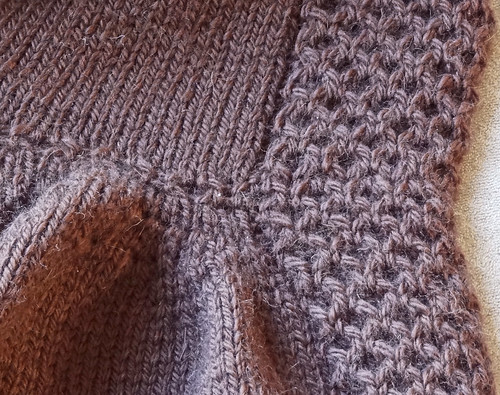I have only been knitting on two things this week, one is a test knit that I have finished, which I will share on Friday, and the other is the ever gorgeous Melia. For those that don't remember, Melia is the first project on my Challenge To Myself AND Knit The Queue 2013. One project ticks both boxes. It's quite sad that it's such a big project to start off both quests, as it is going to take quite some time to finish, but I am loving every minute of it! You can see how much further I've got since my last update.
You can begin to see more clearly how the clever hood construction works now.
The rows of increases after the hood shaping gives the garment lots of room at the back, to create (what will hopefully be) a flowing and roomy cardigan/jacket.
I think knitting on the cable border, as the garment is knit is a very good idea. It saves having to do a huge long pick up of stitches at the finish of the garment, but it also creates a lovely smooth transition from the decreases of the hood shaping to the increases of the body of the garment. If the border was added at the end of kntting the body of the garment there probably would have been gaps at this point. Instead we have this:
Obviously, working a border this way wouldn't work in all cases, but in this one it does. I think Ysolda Teague shows how carefully she designs garments throughout this project. She uses the right technique, in the right place, to create the right effect in the easiest way. You could see this in the hood shaping at the start of the project. You can also see it in the increases in the body of the garment. The increases after the hood shaping are done by knitting into the front and the back of the stitch. This is a simple and quick method of increases, but it isn't invisible. This isn't a problem at this point of the garment because there are lots of increases made closely together, so the individual stitches are hidden in the folds of the knitted fabric. Later in the body of the knitting there are increases made before the armholes are created.
The increases are made almost invisibly. The stitches flow out elegantly from the body into the arms. This is done by using a LLI and RLI (as Ysolda abbreviates it to). This isn't the best increase for all situations as it can show a little gap alongside the stitch the increases are made from, but in a fabric as dense as this (it's knit at a dense gauge) as the body moves into the arm, it's an elegant solution. Knitting Daily has good diagrams, and there is a good YouTube Video to explain this technique.
NEWSFLASH
I have just come across the Pattern Errata for the PRINTED version of this book. It made me double check the PDF I printed off to use. It seems that though I bought the printed copy from Ysolda's website in order to get the PDF version of the book, and all the updates on Ravelry, the digital files on Ravelry had not been updated to reflect the errata that was listed on Ysolda's website as being in the PRINTED version of the book.
On Ysolda's website, it states the current digital version is 1.3, but on Ravelry the most recent version available is 1.2. The single pattern for Melia is listed as being v1.1 and in none of the available digital copies have the column headings changed on the charts for determining stitch and row counts. This means that all the little numbers of stitches and rows I worked out to make this garment fit me perfectly are 2" out. Is it wrong of me to assume that getting the most up to date digital versions of a pattern, on Ravelry, will ensure I have the most up to date pattern available and that it will have been amended the to include the errata from the printed version that were listed on the website? It seems to me to defeat the object of having a digital version on sale.
I also found reference to this errata on Ravelry in a thread **19 months ago, so it's not like there hasn't been time to up date things!!
I am now going to have rip out all the work I've done from the hood downwards because my maths is wrong based on the column headings. I love this pattern dearly and I WILL recalculate and revise the pattern, rip it back and re-knit it, but I really shouldn't have to. It shouldn't be this hard! I'm so upset about this because it such a lovely garment, but looking at the picture below, I really need to do this, because it is gaping at the bust, more than can be explained by trying on the garment with the knitting needle still in the working edge.
So I'm now going to crawl under my comfort blanket and cry for a bit before going over the pattern again and seeing if I can avoid going all the way back to the increases after the hood, because I'm not undoing that as it looks pretty good. Hopefully by this time next week I'll have stopped sobbing and got back on track. I'll keep you posted!
To see people who are going forwards instead of backwards, click on the button.







